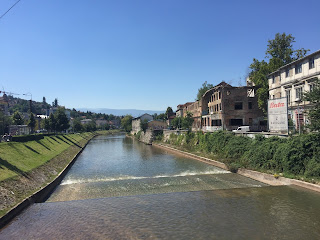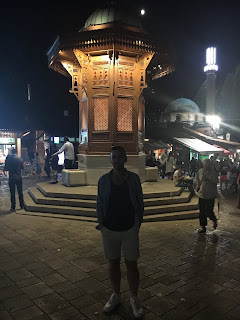Not exactly chipper, we left the hotel
after 11am. We had to leave, as we needed to get the bus tickets for the onward
journey to Mostar tomorrow. So we
filled up on breakfast, then walked our usual route heading west. The food gave
us a bit of energy - something I didn’t think we could have summoned when we
woke - and brought about a discussion on what we could visit or see today. John
came up a trip to the Olympic stadium, built for the 1984 Winter Olympics.
Torvill and Dean territory, I recalled.
On our way to the bus station, we happened
upon a pavement stone engraved with the logo of that year’s Olympics, outside
the modern shopping centre. The stadium was a diversion from the bus station,
so we turned north and instantly began to climb a steep hill. This was a
similar route by which we entered the city when we arrived, which ran along a parallel,
and somewhat quieter, street that edged a park. Half way up, it flattened for a
short period, so we crossed over to the busier road. Even though we only walked
half a mile or so to get to this point, the vista opened up to yet more and
taller hills in the distance, brooding over us. So although the main valley, in
which the city sat, ran east to west, there was this other tributary valley
that came south into the city too. The open expanse that we sat in turned out
to be another of those deadly places to wonder during the siege, and formed part
of the front line. In addition, the buildings on the west side of this valley
were your tall, brutalist kind – which I found unfathomable as to how they
stayed upright on such a steep gradient – and were easily exposed to sniper and
mortar fire.
Once the other side of the park, we came
across a bustling market space that seemed to grow out of an underpass that
carried traffic into the city. Bakeries, taxi ranks, people gathered at bus
stops; it was a hive of activity that was emblematic of the commercial centres
that inhabited the community-minded suburbs of cities in this region. Having
passed by, we saw a tower loom in the distance. It indicated that the stadium
was nearby, as the logo was emblazoned on it. Morbidly, to our right, there was
a large cemetery too.
We walked up and past an indoor arena, to reach
the outdoor stadium itself. This was closed off, but we could get close enough
to peek through the tunnel into the grounds. We then started back down hill to
the indoor arena. Draped outside were many banners showcasing the Olympians
Bosnia had sent to the Summer Olympics in Brasil. We approached the main
entrance, as a sign indicated that there was a museum. Two men in their 40s or
50s were sat outside having a cigarette. We went up a few steps to a 1970s
tinted doorway and pulled at the handle. It was locked. Whilst John looked
around for any signage to indicate opening hours, one of the men called to us
in Serbo-Croatian. I began to walk over and hollered, “English, sorry”. He put
down his coffee and walked towards us.
He said that the museum was closed. John
and I both looked downbeat, especially after that long walk uphill. He
explained that it would not be open for a few days. We said it was a shame, as
we were leaving tomorrow, but that it was nice to come and see the grounds. At
this, he said he could show us inside the indoor arena if we liked. We lit up
with glee. He walked back to the other guy, put out his cigarette whilst
speaking to him, then motioned for us to follow him to another door, the one to
the arena and not the museum.
We emerged into a lobby area that was a
rather darkly lit by the tinted windows that rose above the entrance. Together
with the slight yellowy, beige paint and dark green carpet, its appearance was
placed firmly in the mid 1980s. He took us to our right, into a sort of
cafeteria-cum-common room that was deadly quiet, apart from the lively 1990s TV
playing above our head to the left. There were pictures on the wall here, so I
assumed he could explain a lot more with visual aids. After informing us of
what went on at this site, including the opening ceremony, he took us back to
the lobby and down some stairs. It felt like we were going into the basement.
But once we drew down a floor, we passed through a set of doors into a huge
indoor arena.
It reminded me of my high school gym back
in Wales, one of those that were useful for school assemblies, or to host multiple
of badminton courts. As we gazed at the icons and logos on the walls, and the
sheer space of it, our friend elaborated on what went on in this room. I
couldn’t tell if he was rather excited to see our response, but he gleefully
shared the fact that this was the room in which Torvill and Dean danced the
Bolero, going on to win gold. This genuinely took John and me aback. What a
lovely thing to be treated to, especially when we quite fairly should have been
denied entry.
After departing, we made our descent back
past the market area and turned right to eventually reach the bus station again,
where we purchased our tickets for a 10am coach to Mostar the next day. We
walked from there then, towards the river. Before crossing over, I notice a
marble monument set within a memorial park. It marked the start of the siege on
2 May 1992 by the ‘aggressors’, and was put in place in 2016. I feel the choice
of words was a small step to move beyond ethnicising blame for the siege, and
instead single out all perpetrators.
Now south of the river, and in the
Skenderija quarter, we walked east along the river. It was a glorious day, with
the river looking crisp and clear as it trickled slowly past us. We stopped off
at a small café on the ground floor of a three-story, Austro-Hungarian style
building, typical of this part of town. The terrace was shielded by a
voluptuous gathering of climbers and vines, most in flower. After this short
break, we continued our walk. I wanted to see the synagogue.
We arrived to a closed up courtyard, so had
to peer around the building from the street, away from the river. The building
was, again, in keeping with the aesthetic surrounds, but had Moorish sympathies
reflecting perhaps the dominant Sephardic community who arrived from Spain and
Portugal to Ottoman sanctuary originally, although it was built for the smaller
Ashkenazi community.
After a few photos we retraced our steps,
but this time on a parallel road so that we could have some shade. We walked
past the bridge we crossed over, and continued towards the next one. This
bridge was the site of the murder by sniper fire of two teenagers, Suada and Olga, at the start of the siege. Evidence
was abundant, particularly on the nearby buildings, of the flash point this
area became during the siege. We crossed over, back to the modern shopping
centre and Parliament building.
We decided to eat at
Vapianos, partly in a nod to our friend Jack who loves the place, and because
it had a nice balcony from which to view the goings on below. We consumed an
above average amount of wine for a late-lunch. A walk back to the hotel
naturally followed this, so we had time for a nap.
As it was our last
night, we decided upon a ‘traditional’ restaurant for our last meal. We had
passed it on a walk a couple of days ago, and seems picturesque given it overlooked
the river. The clear twilight was a great canopy under which to sit and eat. We
ordered a hearty meal, with local red wine to devour. Afterwards, we took snaps
of the Town Hall, light up in golden splendour, before walking down the river,
and back across into the Bascarsija. We ended up in the bar we stopped at on
our first night, and had a few beers as a nightcap before calling our time on
Sarajevo on our last full day.











No comments:
Post a Comment